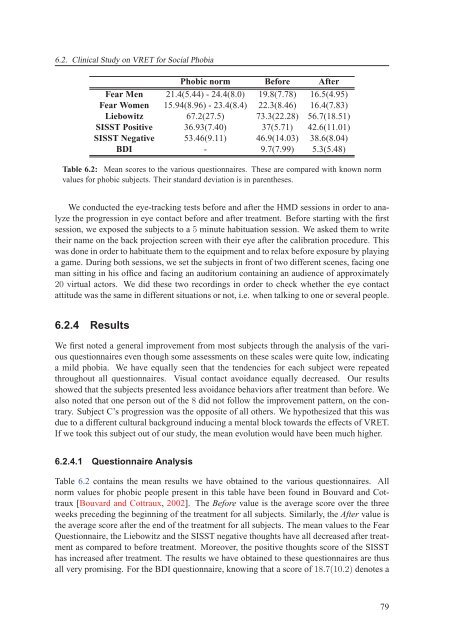Texte intégral / Full text (pdf, 20 MiB) - Infoscience - EPFL
Texte intégral / Full text (pdf, 20 MiB) - Infoscience - EPFL
Texte intégral / Full text (pdf, 20 MiB) - Infoscience - EPFL
You also want an ePaper? Increase the reach of your titles
YUMPU automatically turns print PDFs into web optimized ePapers that Google loves.
6.2. Clinical Study on VRET for Social Phobia<br />
Phobic norm Before After<br />
Fear Men 21.4(5.44) - 24.4(8.0) 19.8(7.78) 16.5(4.95)<br />
Fear Women 15.94(8.96) - 23.4(8.4) 22.3(8.46) 16.4(7.83)<br />
Liebowitz 67.2(27.5) 73.3(22.28) 56.7(18.51)<br />
SISST Positive 36.93(7.40) 37(5.71) 42.6(11.01)<br />
SISST Negative 53.46(9.11) 46.9(14.03) 38.6(8.04)<br />
BDI - 9.7(7.99) 5.3(5.48)<br />
Table 6.2: Mean scores to the various questionnaires. These are compared with known norm<br />
values for phobic subjects. Their standard deviation is in parentheses.<br />
We conducted the eye-tracking tests before and after the HMD sessions in order to analyze<br />
the progression in eye contact before and after treatment. Before starting with the first<br />
session, we exposed the subjects to a 5 minute habituation session. We asked them to write<br />
their name on the back projection screen with their eye after the calibration procedure. This<br />
was done in order to habituate them to the equipment and to relax before exposure by playing<br />
a game. During both sessions, we set the subjects in front of two different scenes, facing one<br />
man sitting in his office and facing an auditorium containing an audience of approximately<br />
<strong>20</strong> virtual actors. We did these two recordings in order to check whether the eye contact<br />
attitude was the same in different situations or not, i.e. when talking to one or several people.<br />
6.2.4 Results<br />
We first noted a general improvement from most subjects through the analysis of the various<br />
questionnaires even though some assessments on these scales were quite low, indicating<br />
a mild phobia. We have equally seen that the tendencies for each subject were repeated<br />
throughout all questionnaires. Visual contact avoidance equally decreased. Our results<br />
showed that the subjects presented less avoidance behaviors after treatment than before. We<br />
also noted that one person out of the 8 did not follow the improvement pattern, on the contrary.<br />
Subject C’s progression was the opposite of all others. We hypothesized that this was<br />
due to a different cultural background inducing a mental block towards the effects of VRET.<br />
If we took this subject out of our study, the mean evolution would have been much higher.<br />
6.2.4.1 Questionnaire Analysis<br />
Table 6.2 contains the mean results we have obtained to the various questionnaires. All<br />
norm values for phobic people present in this table have been found in Bouvard and Cottraux<br />
[Bouvard and Cottraux, <strong>20</strong>02]. The Before value is the average score over the three<br />
weeks preceding the beginning of the treatment for all subjects. Similarly, the After value is<br />
the average score after the end of the treatment for all subjects. The mean values to the Fear<br />
Questionnaire, the Liebowitz and the SISST negative thoughts have all decreased after treatment<br />
as compared to before treatment. Moreover, the positive thoughts score of the SISST<br />
has increased after treatment. The results we have obtained to these questionnaires are thus<br />
all very promising. For the BDI questionnaire, knowing that a score of 18.7(10.2) denotes a<br />
79

















